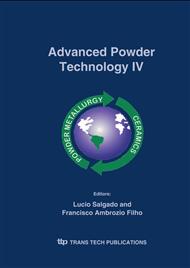p.49
p.55
p.61
p.67
p.73
p.79
p.86
p.93
p.98
Particle Size Distribution Analysis of an Alumina Powder: Influence of Some Dispersants, pH and Supersonic Vibration
Abstract:
It is well known that colloidal powder particles (between 1 mm and 0.001 mm) tend to agglomerate due to electrostatic forces. Then assuring an optimal dispersion condition is essential for good particle-size analysis results, since aggregates or weak agglomerates can be measured as single particles. In this paper the particle size distribution of an alumina powder A1000SG (ALCOA) was measured using distinct dispersion procedures. Distilled water was used as dispersant liquid in the pure state and with additives (citric acid and Duramax D-3005). Dispersion by supersonic vibration was also investigated, but only the application time was varied. Particle size analysis was accomplished by laser scattering technique and the dispersion condition was evaluated through zeta potential. The results showed that the Duramax’s electrosteric impediment is more efficient than citric acid’s electrostatic force, thereby providing better dispersion. Although useful, the supersonic vibration was not good enough to assure an optimal dispersion, at least for the material tested here.
Info:
Periodical:
Pages:
73-78
Citation:
Online since:
November 2005
Keywords:
Price:
Сopyright:
© 2005 Trans Tech Publications Ltd. All Rights Reserved
Share:
Citation:


